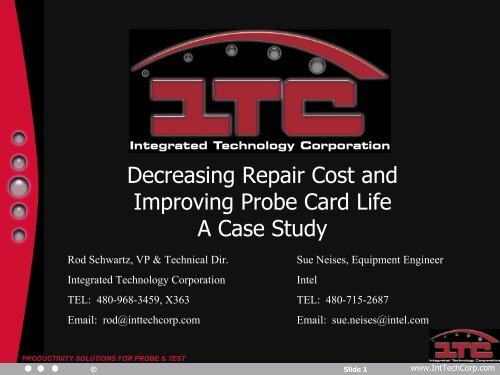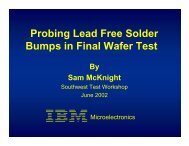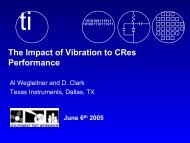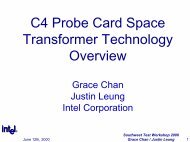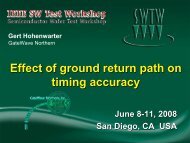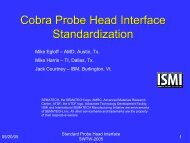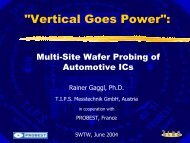Decreasing Repair Cost and Improving Probe Card Life A Case Study
Decreasing Repair Cost and Improving Probe Card Life A Case Study
Decreasing Repair Cost and Improving Probe Card Life A Case Study
You also want an ePaper? Increase the reach of your titles
YUMPU automatically turns print PDFs into web optimized ePapers that Google loves.
<strong>Decreasing</strong> <strong>Repair</strong> <strong>Cost</strong> <strong>and</strong><br />
<strong>Improving</strong> <strong>Probe</strong> <strong>Card</strong> <strong>Life</strong><br />
A <strong>Case</strong> <strong>Study</strong><br />
Rod Schwartz, VP & Technical Dir.<br />
Integrated Technology Corporation<br />
TEL: 480-968-3459, X363<br />
Email: rod@inttechcorp.com<br />
Sue Neises, Equipment Engineer<br />
Intel<br />
TEL: 480-715-2687<br />
Email: sue.neises@intel.com<br />
PRODUCTIVITY SOLUTIONS FOR PROBE & TEST<br />
© Slide 1<br />
www.IntTechCorp.com
Problem Statement<br />
• Cantilever card usage is increasing<br />
• <strong>Repair</strong> costs are increasing<br />
• More repair volume<br />
• More difficult repairs<br />
• Tighter pitch<br />
• Higher pin counts<br />
• More levels of probes<br />
• Operator training is more difficult<br />
• <strong>Cost</strong> of inventory is higher<br />
• <strong>Cost</strong> of down time in wafer sort is higher<br />
© Slide 2
Program Goals<br />
• Lower card repair costs<br />
• Decrease repair times<br />
• Decrease training times<br />
• Reduce card inventory<br />
• Improve ergonomics<br />
• No degradation of repeatability<br />
• No negative safety issues<br />
• If possible, increased probe card life<br />
© Slide 3
Approach to the Solution<br />
• Install <strong>Probe</strong>Tracker option on<br />
existing Probilt PB3500 <strong>Probe</strong> <strong>Card</strong><br />
Analyzers<br />
• Software controlled microscope<br />
• Crosshair positioned to proper probe<br />
location<br />
• True reference for tips up repair<br />
• Correct probe uniquely identified<br />
• No need to “count probes” to find repair point<br />
© Slide 4
<strong>Probe</strong>Tracker option on PB6500<br />
© Slide 5
Positioning Crosshair<br />
© Slide 6
Program Concerns<br />
• Will ergonomics really improve?<br />
• Pinch points <strong>and</strong> safety concerns<br />
• Will repeatability of system be adversely<br />
affected by weight of <strong>Probe</strong>Tracker?<br />
• Will the through-put time (TPT) really be<br />
reduced?<br />
• Setup time required<br />
• <strong>Probe</strong> repair time reduction<br />
• Will probe card life increase significantly?<br />
© Slide 7
Qualification Plan<br />
• Ergonomics <strong>Study</strong><br />
• Wrist assessment<br />
• Microscope positioning<br />
• Manual mode vs automated mode<br />
• Safety Evaluation<br />
• Pinch points<br />
• Motion<br />
© Slide 8
Qualification Plan (2)<br />
• Repeatability <strong>Study</strong><br />
• GR&R – St<strong>and</strong>ard repeatability study<br />
• P/T ≤ 0.15 success criteria<br />
• Throughput <strong>Study</strong><br />
• Time study comparison<br />
• Economic analysis of results<br />
© Slide 9
St<strong>and</strong>ard Microscope Ergonomics<br />
© Slide 10
<strong>Probe</strong>Tracker Ergonomics<br />
© Slide 11
Ergonomics <strong>Study</strong> Results<br />
• Tech spends approx. 2 hrs on system<br />
• St<strong>and</strong>ard Microscope<br />
• 5 min break every 15 min<br />
• 2 hrs 40 min required for 2 hrs productive time<br />
• Improved ergonomics<br />
• No strain on shoulder & wrist<br />
• No extended reach required<br />
• No wrist movement to adjust microscope<br />
• No lost time<br />
© Slide 12
Safety Evaluation Results<br />
• Passed all safety requirements<br />
• No pinch points<br />
• Movements are slow enough for cautionary<br />
moves<br />
© Slide 13
Repeatability <strong>Study</strong> DOE<br />
• 10 consecutive runs of typical card<br />
• Correction factor: 0.9730<br />
• # of st<strong>and</strong>ard deviations: 6<br />
• Parameters Tested<br />
• Alignment (X, Y)<br />
• Leakage<br />
• Planarity<br />
© Slide 14
Repeatability <strong>Study</strong> Results<br />
Parameter<br />
Leakage<br />
Alignment X<br />
Alignment Y<br />
Planarity<br />
UCL-LCL<br />
10<br />
18<br />
18<br />
18<br />
P/T (Avg)<br />
0.02<br />
0.14<br />
0.14<br />
0.14<br />
© Slide 15
Throughput Analysis DOE<br />
• Side by side comparison<br />
• PB3500 #1 with st<strong>and</strong>ard microscope<br />
• PB3500 #2 with <strong>Probe</strong>Tracker option<br />
• Record repair time & # probes repaired<br />
• Calculate repair time per probe<br />
• Include multiple operators (5)<br />
• <strong>Study</strong> results over extended time<br />
© Slide 16
PB3500 #1 – St<strong>and</strong>ard Microscope<br />
Operator<br />
<strong>Repair</strong><br />
Time<br />
<strong>Probe</strong>s<br />
<strong>Repair</strong>ed<br />
Minutes<br />
per <strong>Probe</strong><br />
1<br />
219<br />
27<br />
8.11<br />
2<br />
51<br />
19<br />
2.68<br />
3<br />
69<br />
14<br />
4.93<br />
4<br />
93<br />
6<br />
15.50<br />
5<br />
36<br />
16<br />
2.25<br />
© Slide 17
<strong>Probe</strong> <strong>Card</strong> Mfg: Test/<strong>Repair</strong> (SWTW 2004)<br />
<strong>Card</strong><br />
Mfg A<br />
<strong>Card</strong><br />
Mfg B<br />
<strong>Card</strong><br />
Mfg C<br />
<strong>Card</strong><br />
Mfg D<br />
<strong>Card</strong><br />
Size<br />
300<br />
probes<br />
300<br />
probes<br />
500<br />
probes<br />
1000<br />
probes<br />
% Prb’s<br />
<strong>Repair</strong><br />
10-30%<br />
10-20%<br />
10-20%<br />
10-20%<br />
Test &<br />
<strong>Repair</strong><br />
Time<br />
3-4 hrs<br />
4 hrs<br />
8 hrs<br />
12-16<br />
hrs<br />
Avg <strong>Repair</strong><br />
Time/Prb.<br />
4.7 min<br />
5.3 min<br />
6.4 min<br />
5.6 min<br />
© Slide 18
PB3500 #2 - <strong>Probe</strong>Tracker<br />
Operator<br />
<strong>Repair</strong><br />
Time<br />
<strong>Probe</strong>s<br />
<strong>Repair</strong>ed<br />
Minutes<br />
per <strong>Probe</strong><br />
1<br />
137<br />
49<br />
2.80<br />
2<br />
137<br />
50<br />
2.74<br />
3<br />
21<br />
16<br />
1.31<br />
4<br />
19<br />
4<br />
4.75<br />
5<br />
6<br />
16<br />
0.38<br />
© Slide 19
<strong>Repair</strong> <strong>Cost</strong> Comparison<br />
Parameter<br />
<strong>Cost</strong> = $75/hr<br />
Time/<strong>Probe</strong><br />
<strong>Cost</strong>/<strong>Probe</strong><br />
Avg Reps/<strong>Card</strong><br />
Rep. <strong>Cost</strong>/<strong>Card</strong><br />
<strong>Card</strong>s Rep/mo<br />
<strong>Cost</strong>/mo-2 shft<br />
PB #1, W/O<br />
<strong>Probe</strong>Tracker<br />
$1.25/min<br />
5.7 min<br />
$7.13<br />
27<br />
$192.51<br />
152<br />
$52,671<br />
PB #2, With<br />
<strong>Probe</strong>Tracker<br />
$1.25/min<br />
2.37 min<br />
$2.96<br />
27<br />
$79.92<br />
152<br />
$21,866<br />
© Slide 20
Return on Investment<br />
Return on Investment<br />
$400,000<br />
$350,000<br />
$300,000<br />
Savings, <strong>Repair</strong> <strong>Cost</strong> $<br />
$250,000<br />
$200,000<br />
$150,000<br />
ROI<br />
$100,000<br />
$50,000<br />
$0<br />
1 2 3 4 5 6 7 8 9 10 11 12<br />
Months<br />
© Slide 21
Future Studies <strong>and</strong> Trends<br />
• Confirm increase in probe card life<br />
• Implement/train in other repair centers<br />
• New systems using same technique<br />
• Tips up repair station<br />
• Tips up analyzer/repair station<br />
© Slide 22
PB1200 Tips-Up <strong>Repair</strong> Station<br />
© Slide 23


